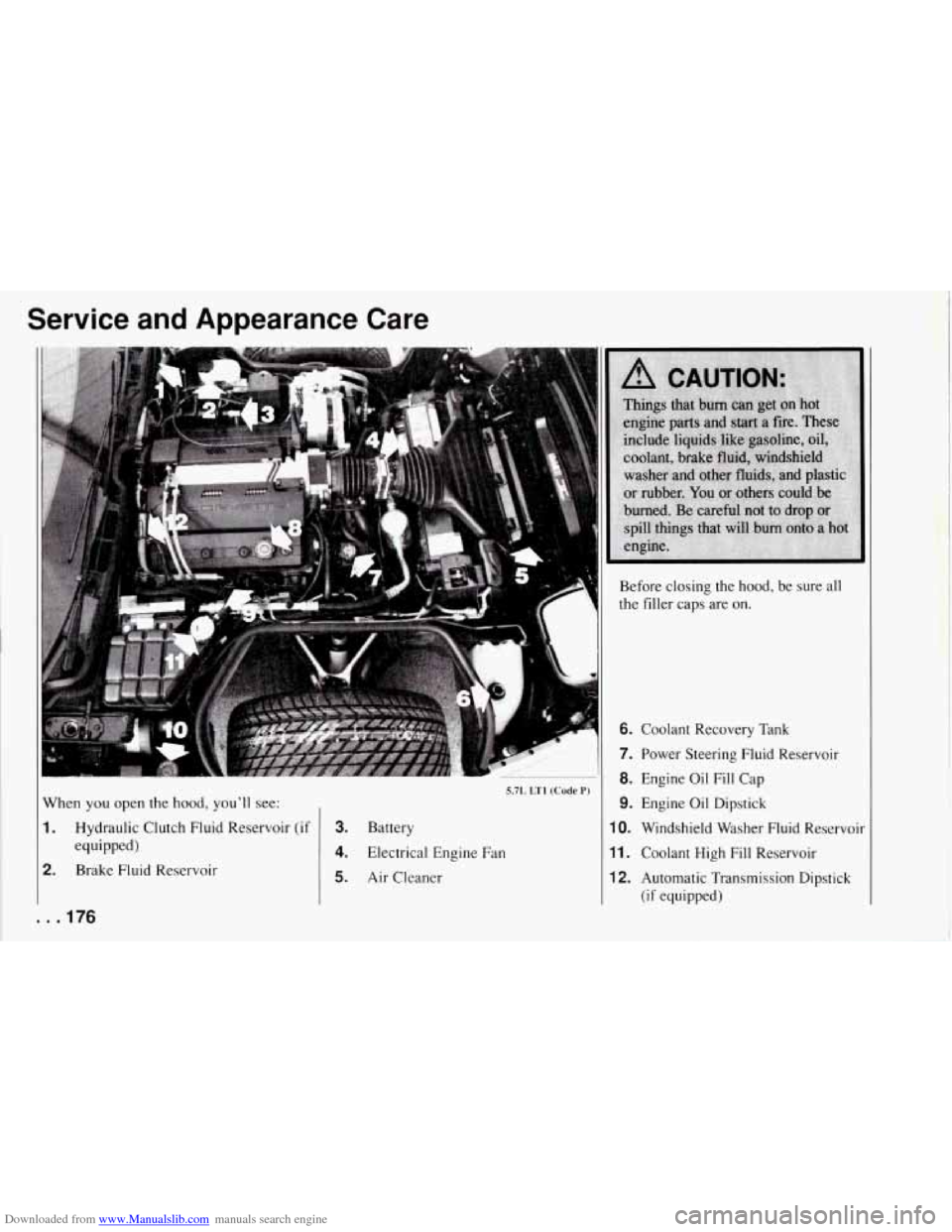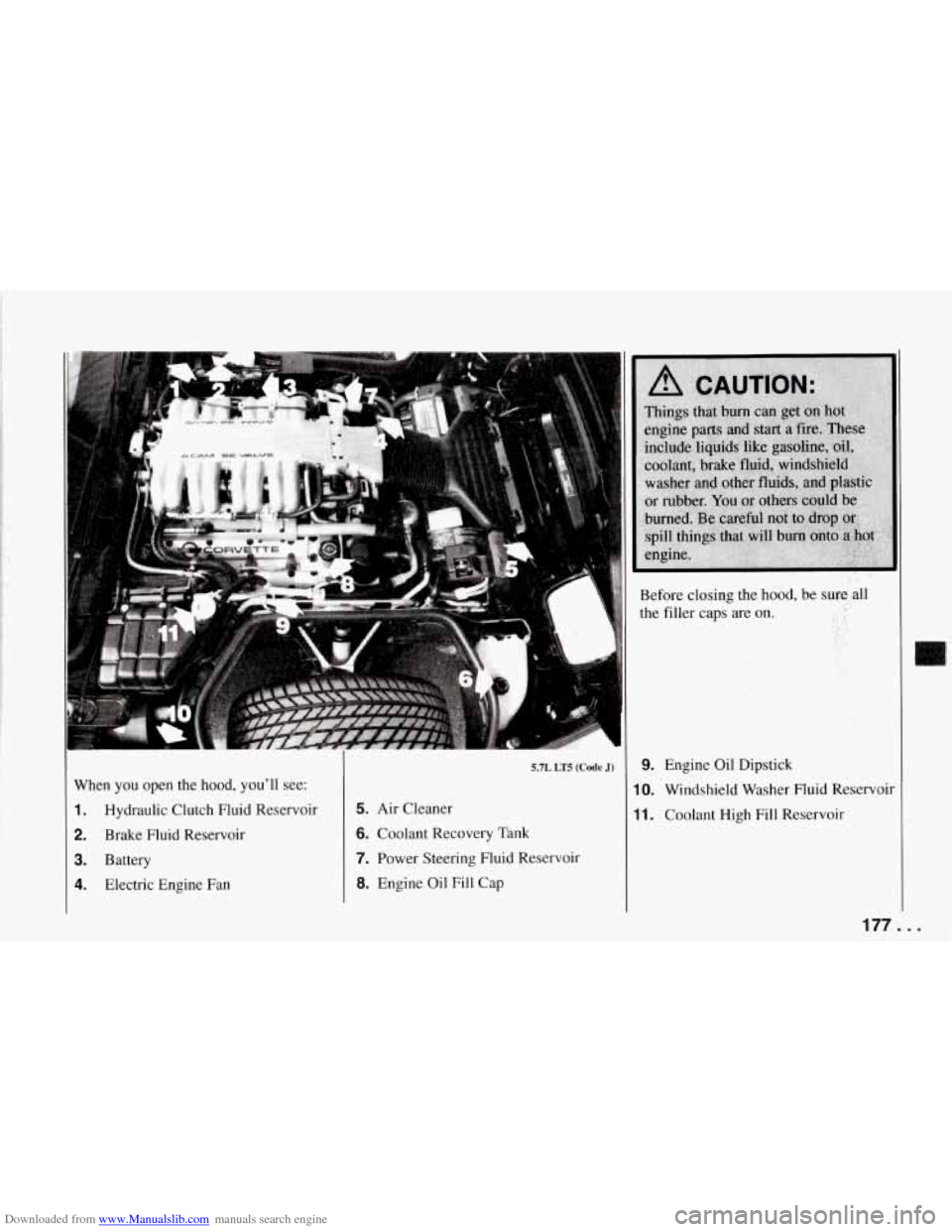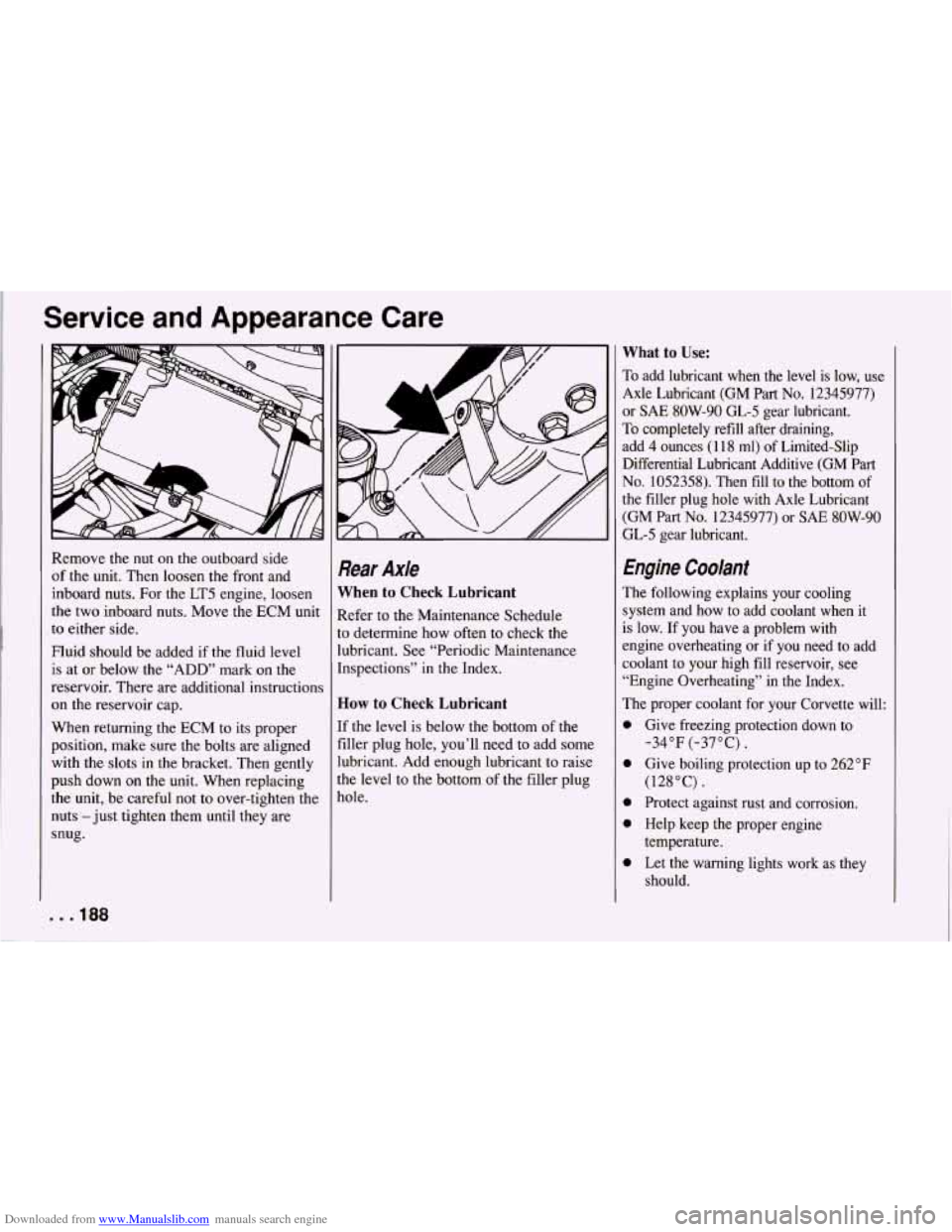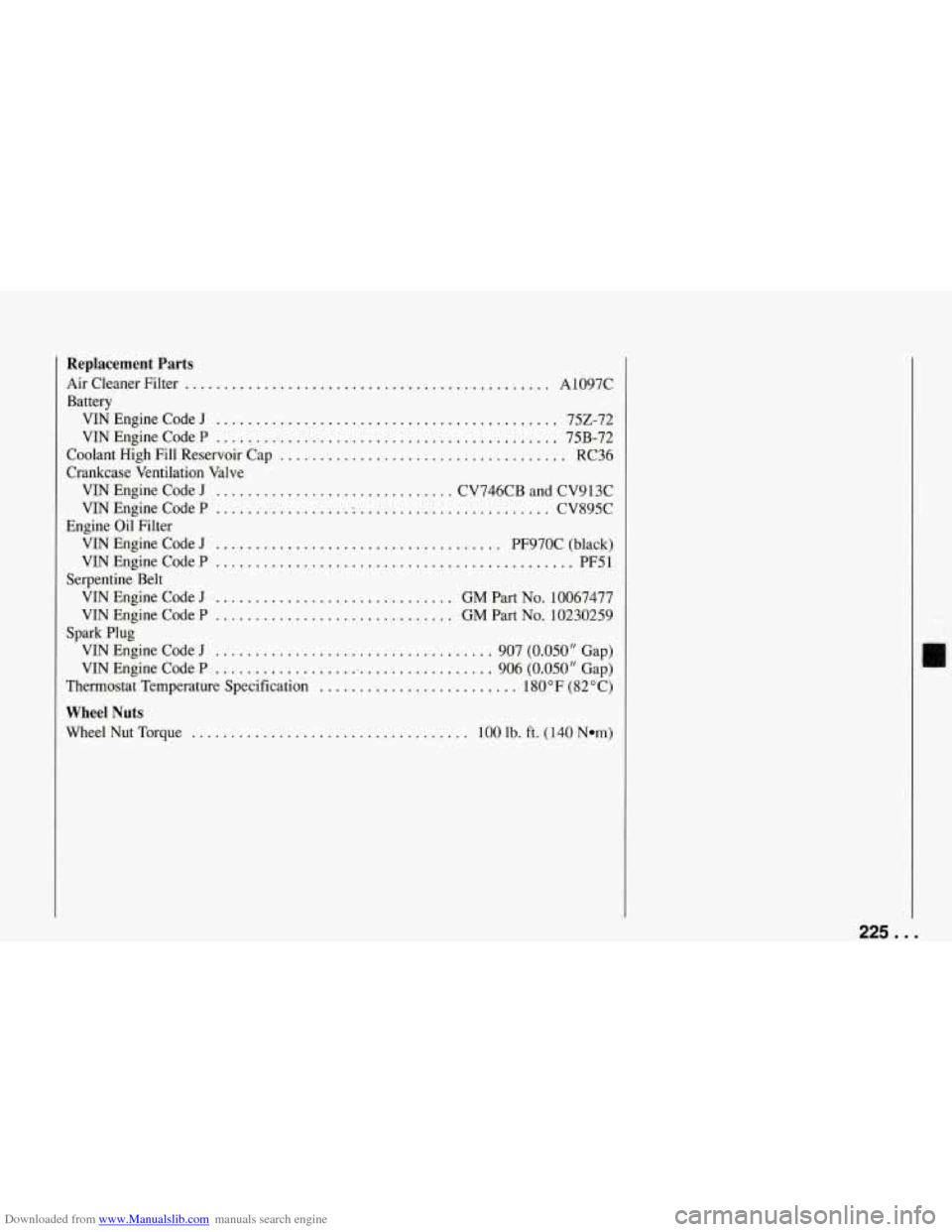1994 CHEVROLET CORVETTE coolant
[x] Cancel search: coolantPage 177 of 274

Downloaded from www.Manualslib.com manuals search engine Service and Appearance Care
When you open the hood, you'll see:
1. Hydraulic Clutch Fluid Reservoir (if
2. Brake Fluid Reservoir
equipped)
. . .I76
1
Before closing the hood, be sure all
the filler caps are on.
'*?-
5.7L LTI (Code P)
3. Battery
4. Electrical Engine Fan
5. Air Cleaner
6. Coolant Recovery Tank
7. Power Steering Fluid Reservoir
8. Engine Oil Fill Cap
9. Engine Oil Dipstick
10. Windshield Washer Fluid Reservoir
11. Coolant High Fill Reservoir
12. Automatic Transmission Dipstick
(if equipped)
I
Page 178 of 274

Downloaded from www.Manualslib.com manuals search engine r
k
"1
5.7L LT5 (Code J)
When you open the hood, you'll see:
1. Hydraulic Clutch Fluid Reservoir 5. Air Cleaner
2. Brake Fluid Reservoir 6. Coolant Recovery Tank
3. Battery 7. Power Steering Fluid Reservoir
4. Electric Engine Fan 8. Engine Oil Fill Cap Before closing
the hood, be
sureall
the filler caps are on. . ..
'., , ,.
9. Engine Oil Dipstick
10. Windshield Washer Fluid Reservoir
11. Coolant High Fill Reservoir
177..
Page 182 of 274

Downloaded from www.Manualslib.com manuals search engine Substitute Oil (LT1 Only): When adding
oil to maintain engine oil level, if an oil
meeting GM Standard GM4718M is not
available, you can use oil designated
either
SAE 5W-30 API Service SH or SG
at all temperatures, or
SAE 1OW-30 API
Service
SH or SG at temperatures above
0°F (-18°C). This oil should not be used
for an oil change.
Substitute Oil (LT5 Only): When adding
oil to maintain engine oil level, if an oil
meeting
GM Standard GM4718M is not
available, you can use oil designated SAE
1OW-30 API Service SH or
SG at all
temperatures. This oil should not be used
for an oil change.
Engine Oil Additives
Don’t add anything to your oil. Your
Chevrolet dealer is ready to advise if you
think something should be added.
When to Change Engine Oil
See if any one of these is true for you:
Most trips are less than 4 miles
It’s below freezing outside and most
trips are less than
10 miles (16 km).
(6 km).
The engine is at low speed most of
the time (as
in stop-and-go traffic).
Most trips are through dusty places.
If any one of these is true for your
vehicle, you need to change your oil and
filter every 3,000 miles
(5 000 km) or
3 months
- whichever comes first.
(See “Engine Oil Life Monitor” in the
Index.)
If none of them is true, change the oil
every 7,500 miles
( 12 500 km) or 12
months
- whichever comes first. Change
the filter at the first oil change and at
every other oil change after that. (See
“Engine Oil Life Monitor” in the Index.)
Engine Coolant Heater (Engine Block
Heater)
An engine coolant heater can be a big
help if you have to park outside in very
cold weather,
0 “F (- 18 “C) or colder. If
your vehicle has this feature, see “Engine
Coolant Heater” in the Index.
What to Do with Used Oil
Did you know that used engine oil
contains certain elements that may be
unhealthy for your skin and could even
cause cancer? Don’t let used oil stay on your
skin for very long. Clean your skin
and nails with soap and water, or a good
hand cleaner. Wash or throw away
clothing or rags containing used engine
oil. (See the manufacturer’s warnings
about the use and disposal of oil
products.)
Used oil can be a real threat to the
environment. If you change your own oil,
be sure to drain all free-flowing oil from
the filter before disposal. Don’t ever
dispose of oil by putting it in the trash,
pouring it on the ground, into sewers, or
into streams or bodies of water. Instead,
recycle
it by taking it to a place that
collects used oil. If you have a problem
properly disposing of your used oil, ask
your dealer, a service station or
a local
recycling center for help. L 1
181 ...
Page 189 of 274

Downloaded from www.Manualslib.com manuals search engine Service and Appearance Care
Remove the nut on the outboard side
of the unit. Then loosen the front and
inboard nuts. For the LT5 engine, loosen
the two inboard nuts. Move the ECM unit
to either side.
Fluid should be added if the fluid level
is at or below the “ADD” mark on the
reservoir. There are additional instructions
on the reservoir cap.
When returning the ECM to its proper
position, make sure the bolts are aligned
with the slots in the bracket. Then gently
push down on the unit. When replacing
the unit, be careful not to over-tighten the
nuts -just tighten them until they are
snug.
. . * 188
Rear Axle
When to Check Lubricant
Refer to the Maintenance Schedule
to determine how often to check the
lubricant. See “Periodic Maintenance
Inspections” in the Index.
How to Check Lubricant
If the level is below the bottom of the
filler plug hole, you’ll need to add some
lubricant. Add enough lubricant to raise
the level to the bottom of the filler plug
hole.
What to Use:
To add lubricant when the level is low, use
Axle Lubricant (GM Part
No. 12345977)
or
SAE 8OW-90 GL-5 gear lubricant.
To completely refill after draining,
add 4 ounces (1 18 ml) of Limited-Slip
Differential Lubricant Additive (GM Part
No. 1052358). Then fill to the bottom of
the filler plug hole with Axle Lubricant
(GM Part
No. 12345977) or SAE 8OW-90
GL-5 gear lubricant.
Engine Coolant
The following explains your cooling
system and how to add coolant when
it
is low. If you have a problem with
engine overheating or
if you need to add
coolant to your high fill reservoir, see
“Engine Overheating” in the Index.
The proper coolant for your Corvette will:
0
0
0
0
0
Give freezing protection down to -34°F (-37°C).
Give boiling protection up to 262°F
(128°C).
Protect against rust and corrosion.
Help keep the proper engine
temperature.
Let the warning lights work as they
should.
Page 190 of 274

Downloaded from www.Manualslib.com manuals search engine What to Use:
Use a mixture of one-half clean water
(preferably distilled) and one-half
antifreeze that meets “GM Specification
1825-M,” which won’t damage aluminum
parts.
You can also use a recycled coolant
conforming to GM Specification 1825-M
with a complete coolant flush and refill.
If you use this mixture, you don’t need to
add anything else.
NOTICE:
If you use an improper coolant mix,
your engine could overheat and be
badly damaged. The repair cost wouldn’t be covered by your
warranty.
Too much water in the mix
can freeze and crack the engine,
radiator, heater core and other parts.
Adding Coolant
I’o Check Coolant When your engine is
;old, check the dipstick on the cap of the
;oolant recovery tank. The coolant level
should be at “COLD,” or a little higher.
When your engine is warm, the level on
the dipstick should be up to “HOT,” or a
little higher.
Your Corvette also has a coolant high fill
reservoir located at the right rear of the
engine compartment.
189 ...
Page 191 of 274

Downloaded from www.Manualslib.com manuals search engine Service and Appearance Care
If you need to add more coolant, add the
proper mix at
the coolant recovery tank,
but only when your engine is cool. If the
tank is very low or empty, also add
coolant to the coolant high fill reservoir.
See “Engine Overheating”
in the Index
for information.
. . .190
Add coolant mix at the recovery tank, but
be careful not to spill it.
NOTICE:
You can be burned if you spill coolant
on hot engine parts. Coolant contains
ethylene glycol, and it will burn if the
engine parts are hot enough. Don’t
spill coolant on a hot engine.
For complete drain, flush and refill
of
the engine, contact your Chevrolet
jealer or the procedure may be found in
3 Chevrolet Corvette Service Manual. To
purchase a service manual, see “Service
Publications” in the Index.
Thermostat
Engine coolant temperature is controlled
by a thermostat in
the engine coolant
system. The thermostat stops the flow of
coolant through the radiator until the
coolant reaches a preset temperature.
When you replace your thermostat, an
AC@ thermostat is recommended.
Page 226 of 274

Downloaded from www.Manualslib.com manuals search engine Replacement Parts
AirCleanerFilter .............................................. A1097C
Battery VINEngineCodeJ
........................................... 752-72
VIN Engine Code P
........................................... 75B-72
Coolant High Fill Reservoir Cap
.................................... RC36
Crankcase Ventilation Valve VIN Engine Code J
.............................. CV746CB and CV9 13C
VIN Engine Code P
................. : ........................ CV895C
VIN Engine Code
J .................................... PF970C (black)
VINEngineCodeP
............................................. PF51
VIN Engine Code J
.............................. GM Part No. 10067477
VIN Engine Code P
.............................. GM Part No. 10230259
VIN Engine Code
J ................................... 907 (0.050" Gap)
VIN Engine Code P
.................................... 906 (0.050" Gap)
Thermostat Temperature Specification
......................... 1 80 "F (82 O C)
Wheel Nuts
Wheel Nut Torque ................................... 100 lb. ft. ( 140 Nam)
Engine Oil Filter
Serpentine Belt
Spark Plug
225. ..
Page 237 of 274

Downloaded from www.Manualslib.com manuals search engine Maintenance Schedule
C L Section A: Scheduled Maintenance Services (Cont.)
Explanation of Scheduled
Maintenance Services
Following are explanations of the services
listed in Schedule I and Schedule
11.
The proper fluids and lubricants to use are
listed in Section D. Make sure whoever
services your vehicle uses these. All parts
should be replaced and all necessary
repairs done before you or anyone else
drives the vehicle.
NOTE: To determine your engine’s
displacement and code, see
“Engine Identification” in the
Index.
ITEM
NO. SERVICE
1 Engine Oil and Filter Change* -
Always use SH or SG Energy
Conserving I1 oils of proper
viscosity. The engine requires a
special oil meeting GM Standard
GM4718M. Oils meeting this
Standard may be identified as
synthetic, and should also be
identified as API Service
SH or
SG. However, not all Synthetic
API Service
SH oils will meet
ITEM
NO. SERVICE
this GM Standard. You should
look for and use only an oil that
meets GM Standard GM4718M.
To determine the preferred
viscosity for your vehicle’s
engine (e.g.,
SAE 5W-30 or SAE
10W-30), see “Engine Oil” in
the Index.
Your vehicle has an Engine Oil
Life Monitor. This monitor will
show you when to change the oil
- usually between 3,000 miles
(5 000 km) and 7,500 miles
( 12 500 km) since your last oil
change. Under severe conditions
the indicator may come on before
3,000 miles
(5 000 km). Never
drive your vehicle more than
7,500 miles (12
500 km) or 12
months without an oil change.
The system won’t detect dust in
the oil..
So if you drive in a dusty
area be sure
to change your oil
every 3,000 miles
(5 000 km) or
sooner if the “Change Oil” light
comes on.
ITEM
NO.
2
3
4
SERVICE
Remember to reset the Oil Life
Monitor when the oil has been
changed. For more information, see “Engine Oil Life Monitor”
in the Index.
Chassis Lubrication
- Lubricate
suspension and steering linkage.
Lubricate the transmission shift
linkage, and parking brake cable guides, underbody contact points
and linkage.
Engine Accessory Drive Belt(s) Inspection
- Inspect the belt(s)
for cracks, fraying, wear and
proper tension. Replace as needed. (Belts can have many
small cracks in individual ribs
without affecting performance.)
Cooling System Service*
-
Drain, flush and refill the system with
new or approved recycled
coolant conforming to GM
Specification 1825M. Keep
coolant at the proper mixture as
specified. See “Coolant” in the
* An Emission Control Service.
. . .236